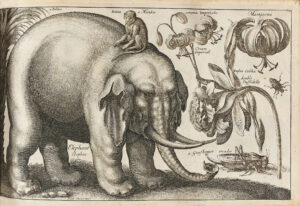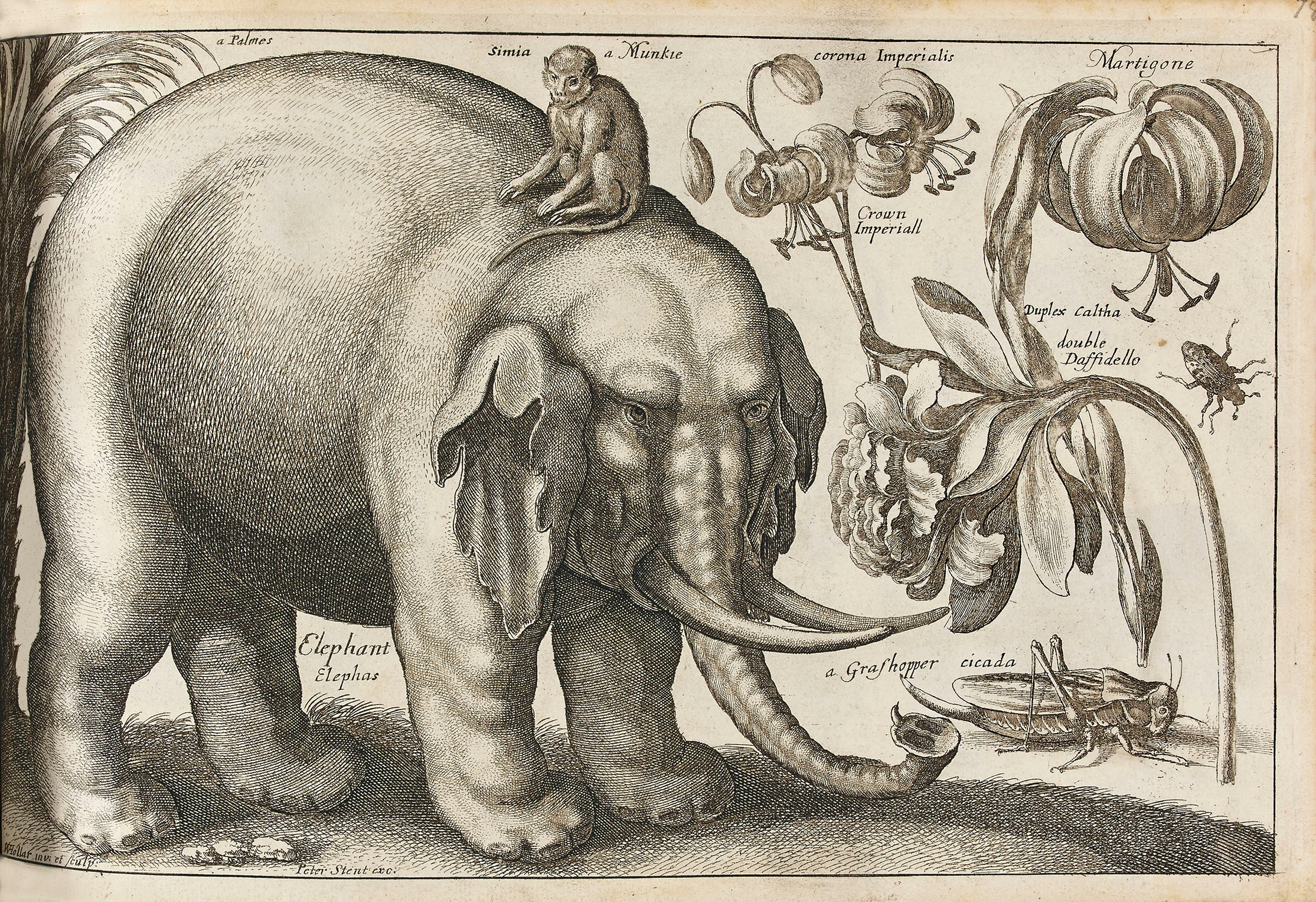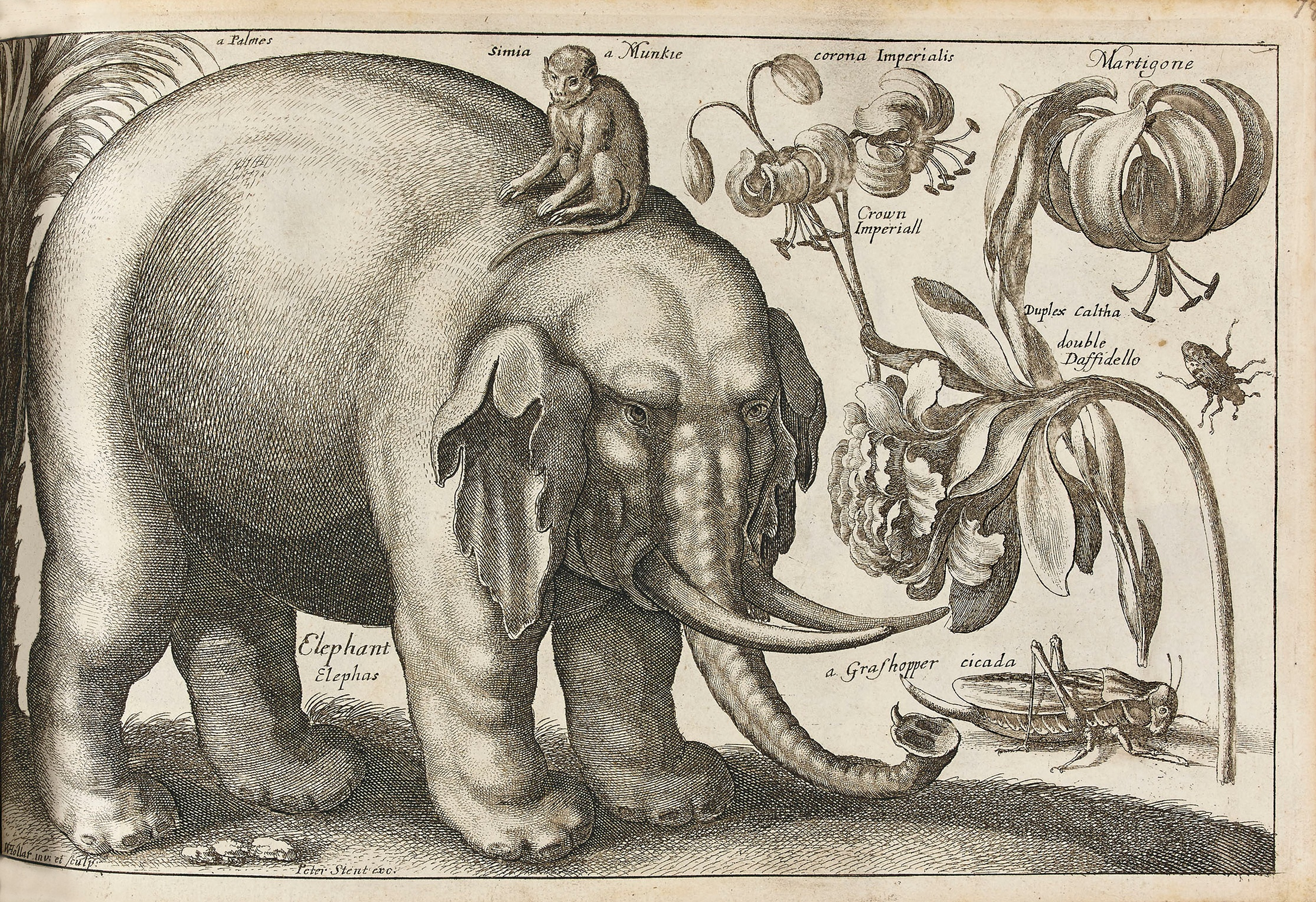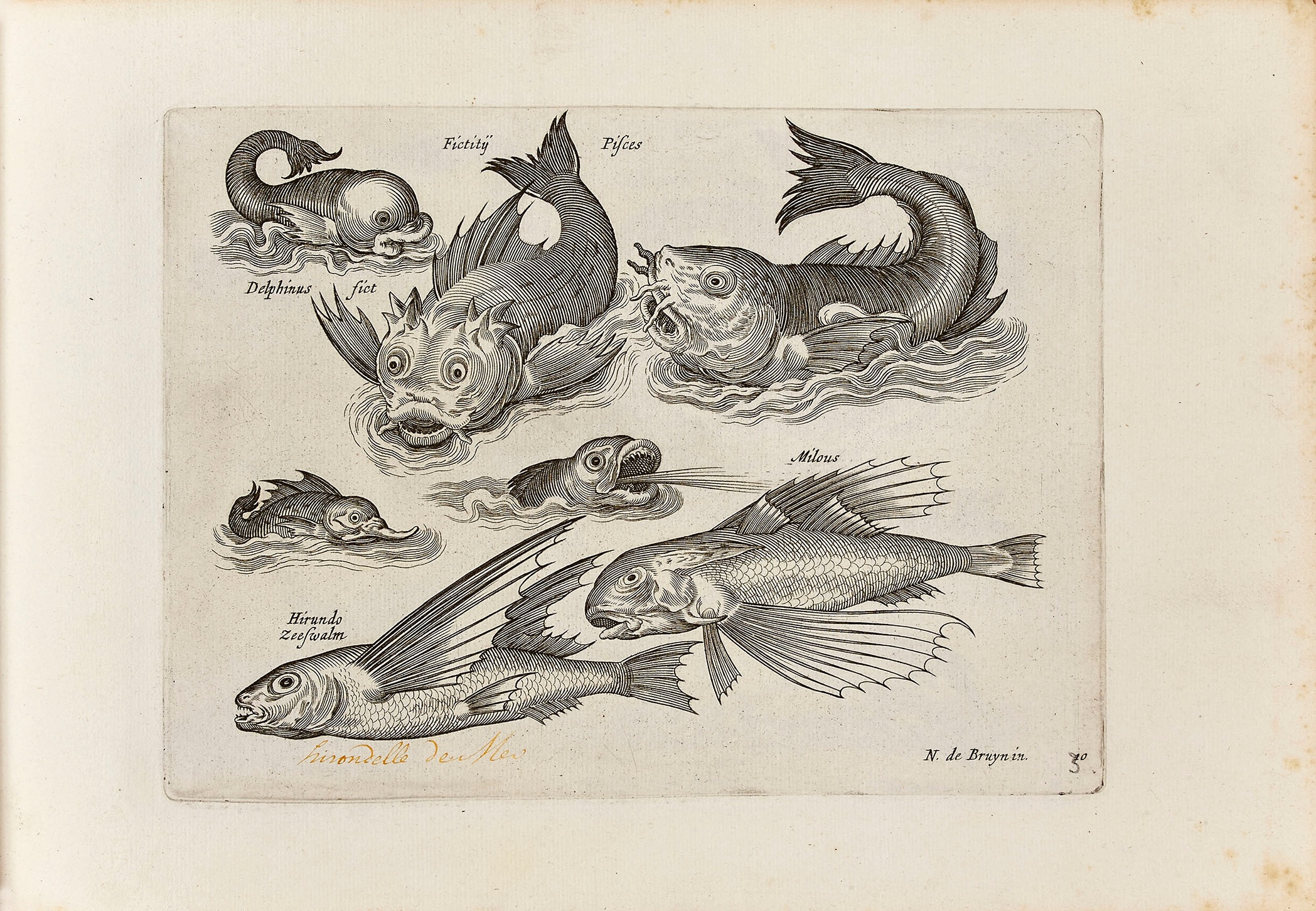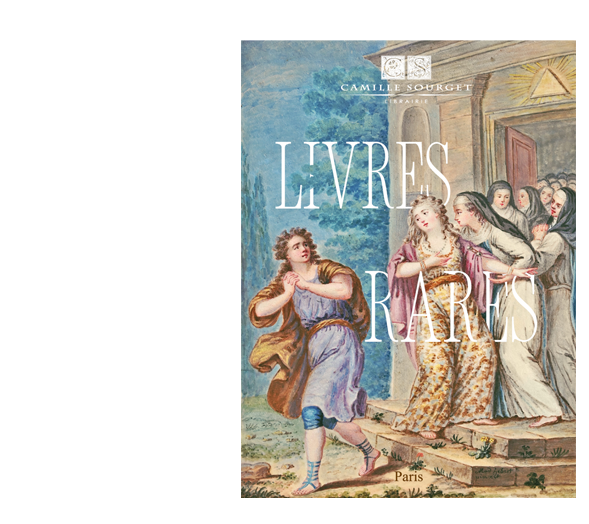[Amsterdam], Nic. Jos. Visscher, 1634.
Title and 19 plates numbered from 2 to 20.
First edition given in Amsterdam in 1634, complete with its 20 fish plates, and second general edition different from the first printed in Antwerp around 1610.
Nissen, Zoologische, p. 98.
II-Bruyn, Nicolaes de. Libellus varia genera piscium complectens Pictoribus, sculptoribus, caelatoribus, aurifabris etc. mire utilis et necessarius.
Nicolaes de Bruyn inventor, Claes J. Visscher, ca. 1630.
Antwerpen um 1550 – 1656 Rotterdam (Th.-B.)
4to with 1 frontispiece and 12 prints of fishes and amphibians numbered from 2 to 13. First plate spotted, small tears restored in the margin of pl. 3, 4, 11 and 12.
First edition described by Nissen, Zoologische, p. 69.
III- Collaert, Adriaen. Avium Vivae et artificiosissimae Delineationes.
Amstelodami, impressae apud Nicolaum Visscher, Anno 1659.
Oblong 4to, 1 frontispiece and 23 bird prints numbered 2 to 24. Small rest. in the margin of pl. 4, 10, 15 and 24; pl. 6, 11 and 18 spotted.
IV- Wenzel Hollar, Henri Le Roy / Weyen, Herman.
6 prints of multiple birds.
V- Wenzel Hollar, Henri Le Roy / Weyen, Herman. Muscarum Scarabeorum Vermiung Varie Figure & Formae omnes primo ad vivum coloribus depictae & ex Collectionne Arundeliam.
Paris, rue St Jacques, 1651.
Oblong 4to of 6 prints of multiple butterflies, insects, beetles, caterpillars, grasshoppers etc. including the title (Nissen, Zoologische, 206).
VI- Wenceslas Hollar. Animalium, ferarum & Bestiarum, Florum, Fructuum, Muscarum, Vermiumq: Icones variae, omnes ad vivum delineatae, per Wenceflaum Hollar, & In lucem editae a Petro Stent, Londini, A° 1663.
A New and perfect Book, of Beasts, Flowers Fruits, butterflies, & other Vermines Exactly drawne after v° life & naturall by W. Hollar.
Printed and are to be sould, by Iohn Onertonat the White Horse : without New-Gate, London, A° 1674.
Title and 11 superb prints of flowers and animals engraved in 1662 and 1663 followed by 4 landscape prints by Hollar and Chauveau engraved by L. Galle. Plate 1 spotted, fold in plate 2, small tear restored on plates 3 and last.
VII- Le Pautre.
3 prints presenting 6 engravings of baroque decoration by Mariette.
VIII- Perelle.
56 plates. Seasons, views of the castles of Versailles, Vincennes, Tuileries… and various landscapes.
Paris, Langlois and Leblond. n.d.
IX- Poilly. Elements of baroque decoration.
9 plates.
X- Ducerceau, A. Divers Ornements de feuillages en forme de panneau…
Paris, de Poilly, n.d.
Title and 4 plates. [At the end]. 2 German engravings. [N.-D. de Paris, Pont Saint-Michel] + 3 unsigned landscapes. 2 spotted plates.
A total of 10 extremely rare 16th century engravings presenting 159 engravings of birds, insects, butterflies, flowers, beetles, animals, landscapes, seasons, houses, parks and castles, elements of baroque decorations, fishes, views of Paris, bound in 1 volume 8vo Italian style, marbled calf, gilt border around the covers, ribbed decorated spine, red edges. 19th century binding.
284 x 183 mm.
First issue of the exceedingly rare suite of Nicolas de Bruyn born in Antwerp in 1550 accompanied by 8 exceedingly rare suites of the 17th century by the best Western artists : Adrian Collaert, Wenzel Hollar, G. Perelle, Poilly and Ducerceau.
“For modest purses, small albums of plates on flowers and animals were published in the Netherlands in the 17th century. One of the most remarkable is the little bird book of the Flemish copper engraver Adriaan Collaert (Antwerp, ca. 1560-1618). Little is known about him personally: we know that he was admitted to the St. Luke’s Guild and that in 1586 he married the daughter of Philippe Galle, a copper engraver and print publisher, in whose workshop he began.
Under the titles “Avium vivae icones” and “Avium iconum edition secundo” two series of 16 engravings of birds are published, executed by Collaert in 1580 and around 1600 respectively. In the first, each bird is given a Latin name. Most of the figures represent native species, such as magpies, jays, starlings, sparrows, great tits, European waxwings, etc. There are also a few selected species of domestic animals: roosters, pigeons, etc., as well as exotic birds: ostriches, crowned cranes, guinea fowl and parrots. The second series, numbered from 1 to 16 (including the title page), is not a reprint of the first, as the title would suggest, but a continuation. After some native birds, which were already in the first collection, the choice extends to rarer birds, both native and exotic. Most of the time, there are two subjects presented on a single plate, but the size ratio of one species to the other is not respected. On the other hand, the birds seem to be mostly drawn from life. Their attitude, for example that of the parrot eating cherries is very natural. In contrast to his predecessors, Collaert presents his birds in a landscape and places an easily recognizable plant or tree in the foreground on most of the plates. Without wanting to find in him a precursor of those who represented the habitat, one can, in any case, suppose that his new way of presenting birds is the origin of the most beautiful later ornithological illustrations.
The bird plates of Adriaan Collaert are also of great scientific value. A.C. Oudemans sees in A. Collaert’s Avis indica (here on plate 16), the only known representation of the Laguatia gigantea Schlegel, which Dutch sailors had brought back from Mauritius around 1599 or 1600 and which had been exhibited in the garden of Count Van Solms on the Boitenhof in The Hague. In the Voyages et aventures de François Leguat et de ses compagnons en deux îles désertes des Indes orientales (London, 1708, p. 171), we find the description of this woodcock that Schlegel named Leguatia, because he believed that Leguat’s engraving was the only image of this extinct species. The illustration that Leguat gives of his Géans, appears clearly as a very clumsy copy of the Avis indica, of which one read the history above. After a very eventful crossing, which earned him the nickname of “French Robinson”, Leguat landed in Flushing. He probably prepared his manuscript for publication in the Netherlands, where he had already taken refuge in 1689 after the revocation of the Edict of Nantes.
It can be said that Collaert’s plate is the only good representation of this extinct bird. If Schlegel had known about it, he might have given the Geans the name Collaersia” (Exhibition catalog of the Royal Library of Belgium “En toute sorte de plume“, 1968).
The editions given by the Royal Library of Belgium are the following:
I. Avium vivae icones, in aes incisae et editae ab Adriano Collardo, 16 pl. Obl. 8vo. Antverpiae, n.d. [ca. 1580 according to Engelmpan], not 17 leaves indicated by Nissen (199).
2. Avium iconum editio secunda. Adrianus Collaert fecit et excudit. 16 pl. Antverpiae, n.d. obl. 4to.
3. Avium vivae icones, in aes incisae et editae ab Adriano Collardo et Theodaro Galineo. Obl. 8vo. 32 pl. s. loc. [Antverpiae], n.d. [1637].
4. Avium vivae icones, Adriano Collardo inventore, excisae apus C. J. Visscher. Anno 1625. [Antverpiae]. According to Nissen 18 pl.
5. Casey Wood also points out an Avium vivae icones, Anumtissima imitatio earum atiae incisea et edige sunt… edited by G. B. Rossi, Piazza Navona, [Roma]. 16 plates (including frontispiece). Since Hollstein, who has so far compiled the most complete inventory of Collaert’s work, does not mention it, it is not without interest to include here a description of this Italian edition, according to the copy in the McGill University Library: “one of the artist’s earliest and best album of bird life. Evidently first states of the plate and before all letters (except the systematic natures of the birds). A very clean, clear copy. Very rare in this condition”.
6. Clauss Nissen reports another edition with 30 illustrations by F. de Witt, Antwerp, around 1640.
7. The present edition given in Amsterdam in 1659 seems unknown to bibliographers.
A superb set of 159 seventeenth-century prints of the utmost rarity.
See less information
